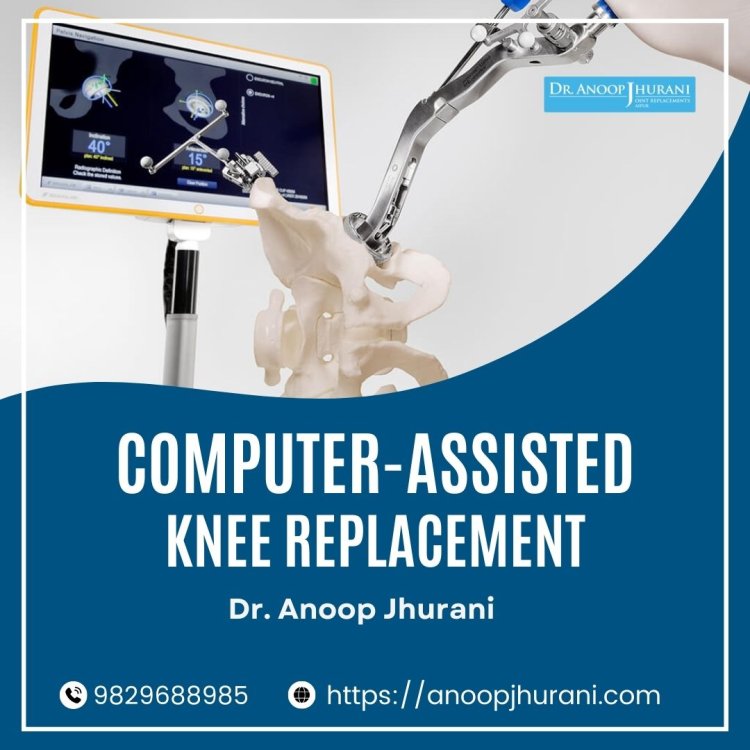Benefits of Computer-Assisted Knee Replacement Surgery
In Jaipur, Dr. Jhurani is an expert in computer-assisted knee replacement. Computer navigation helps the surgeon to get 100% accuracy.
Share this Post to earn Money ( Upto ₹100 per 1000 Views )

Medical technology continues to evolve, bringing about significant advancements in the field of surgery. Among these innovations, computer-assisted knee replacement surgery stands out as a revolutionary approach that combines the expertise of skilled surgeons with the precision of cutting-edge technology. We'll explore the remarkable benefits of computer-assisted surgery, with a particular focus on its role in improving prosthetic balance, prosthesis positioning, and knee functionality, leading to an early return to an active lifestyle, reduced discomfort, and a lower risk of complications like fat embolism.
1. Enhanced Prosthetic Balance: One of the key advantages of computer-assisted surgery is its ability to achieve optimal prosthetic balance for patients. By utilizing computer algorithms and real-time feedback, surgeons can fine-tune the alignment and positioning of prosthetic implants, ensuring a symmetrical distribution of forces across the joint. This enhanced balance can significantly improve the patient's stability, mobility, and overall quality of life.
2. Precise Prosthesis Positioning and Alignment: Traditional joint replacement surgeries heavily rely on the surgeon's skill and experience in positioning and aligning prosthetic implants. However, even experienced surgeons may encounter challenges in achieving absolute precision. CAS addresses this concern by providing detailed pre-operative planning and intra-operative guidance. The technology enables surgeons to make precise adjustments during the surgery, resulting in improved implant placement and better overall outcomes.
3. Improved Knee Functionality: Computer-assisted surgery offers a level of accuracy that is unmatched by conventional methods. By ensuring optimal alignment and positioning of the prosthesis, patients experience improved knee functionality, reduced joint wear, and a reduced risk of complications like implant loosening. This can lead to greater joint stability, smoother motion, and enhanced performance during activities.
4. Early Return to an Active Lifestyle: CAS not only improves surgical outcomes but also promotes faster postoperative recovery. With more precise implant positioning and reduced trauma to surrounding tissues, patients experience reduced pain and discomfort after surgery. Consequently, they can begin rehabilitation and physical therapy sooner, leading to an earlier return to their daily activities and active lifestyles.
5. Reduced Discomfort: Traditional joint replacement surgeries may result in postoperative pain due to misalignment or improper implant positioning. In contrast, computer-assisted surgery significantly reduces the likelihood of such issues, thereby minimizing discomfort and pain after the procedure. This improvement in patient comfort enhances the overall surgical experience and aids in a smoother recovery.
6. Lower Chance of Fat Embolism: Fat embolism is a rare but serious complication that can occur during joint replacement surgeries. It happens when fat particles from the bone marrow enter the bloodstream and can lead to severe respiratory and neurological problems. By enhancing surgical precision and reducing bone trauma, computer-assisted surgery lowers the risk of fat embolism, further improving patient safety.
Conclusion:
Computer-assisted surgery has emerged as a game-changer in the field of joint replacement and other surgical procedures. Its ability to improve prosthetic balance, enhance prosthesis positioning and alignment, boost knee functionality, promote an early return to an active lifestyle, reduce discomfort, and lower the chances of complications like fat embolism make it a valuable tool for healthcare professionals and patients alike. As technology continues to advance, we can expect even more remarkable innovations in the realm of computer-assisted surgery, further revolutionizing the world of modern medicine.





![Goa“Call “Girls Varca ] [ 9289866737 ] Escorts“Call “Girl In Goa]](https://blog.rackons.in/uploads/images/202409/image_380x226_66f5397747a04.jpg)
![Goa“Call “Girls Panjim ] [ 9289866737 ] Escorts“Call “Girl In Goa]](https://blog.rackons.in/uploads/images/202409/image_380x226_66f53c3bc46e0.jpg)